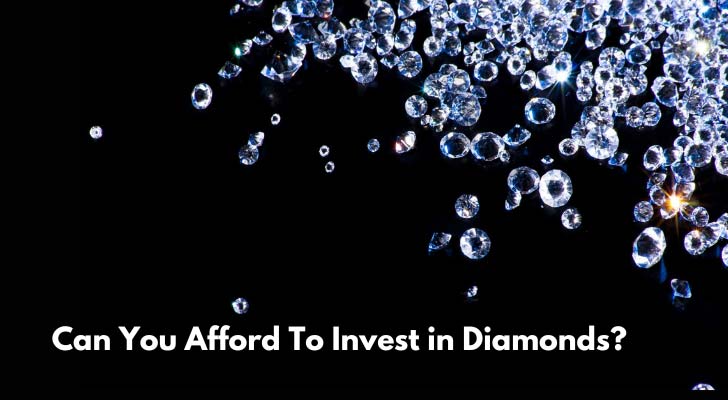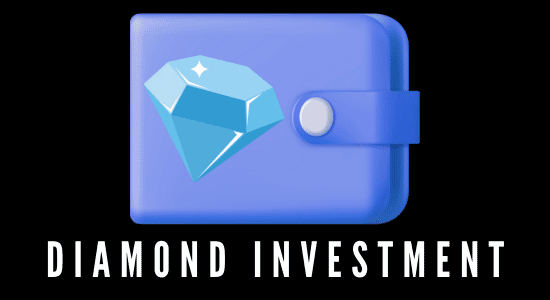Investing in diamonds is obviously good. Diamonds are most likely to hold their value forever and even appreciate over time. But buying them can be a complex process and requires a certain level of knowledge and expertise. If you don't have proper knowledge then, you'll be relying on a professional in the field.
But at least you can try understanding a few things; diamond grading and certification, current market trends and pricing. You should really consult with a reputable jeweler or investment advisor who specializes in diamonds to get advice and guidance on making informed investment decisions. How much can you afford to invest in diamonds, anyway?

Did You Know?
- Price Volatility: Unlike gold, diamonds exhibit higher price volatility, making their market less predictable.
- Market Size: The global diamond market is valued at approximately $80 billion in retail sales of diamond jewelry.
- Investment Grade Diamonds: Only 0.1% of mined diamonds are considered investment grade.
- Color and Clarity: Diamonds with exceptional color (D, E, F) and clarity (FL, IF) are often more sought after by investors.
- Historical Appreciation: High-quality investment-grade diamonds have historically appreciated at a rate of 3-4% per year.
The Diamonds Basics
Several types of diamonds differ in terms of color, cut, shape and quality. Here are the basics to start with:
- Natural diamonds: These are diamonds that are formed deep within the earth's mantle over millions of years through a natural process of extreme heat and pressure.
- Lab-grown diamonds: These are diamonds that are created in a laboratory setting using advanced technology that simulates the natural process of diamond formation. They have the same chemical and physical properties as natural diamonds but are created in a shorter amount of time and at a lower cost.
- Colored diamonds: These are diamonds that have a natural color, which is caused by trace elements or structural defects within the diamond's crystal lattice. Colored diamonds can come in a range of colors, including yellow, brown, pink, blue, green, and red.
- Treated diamonds: These are diamonds that have been treated to enhance their color, clarity or both. Treatments can include laser drilling to remove inclusions, high-pressure and high-temperature (HPHT) treatments to improve color, or irradiation to change color.
- Synthetic diamonds: These are diamonds that are created in a laboratory setting but are not meant to imitate natural diamonds. Synthetic diamonds are often used in industrial applications, such as cutting tools or electronics, due to their hardness and durability.
Did You Know?
- Size Matters: Diamonds over 2 carats can often be better investments due to their rarity and demand.
- Lab-Grown Market: The lab-grown diamond market is expected to grow significantly, impacting the value of natural diamonds.
- Market Accessibility: Entry barriers for individual investors are high due to the need for expertise and significant capital.
- Resale Value: The resale value of diamonds can vary widely, typically 30-50% less than retail value.
- Certification Importance: GIA certification is crucial for ensuring the quality and facilitating the resale of investment diamonds.
The Color Scales
Diamond color is graded on a scale from D (purest white) to Z (light yellow), with D being the most valuable and sought after. The scale was developed by the Gemological Institute of America (GIA) and is used to describe the amount of color present in a diamond.
A D-color diamond is completely colorless, with no visible tint of yellow or brown, and is considered the rarest and valuable of all diamond colors. As you move down the color scale, the diamond will have a slightly yellow or brown tint.
Here is a breakdown of the color scale:
- D, E, F: Colorless or nearly colorless, with no visible tint of yellow or brown.
- G, H, I, J: Near colorless, with a slight yellow or brown tint that is typically only visible when compared to diamonds of higher color grades.
- K, L, M: Faint yellow or brown tint that is visible to the naked eye.
- N - Z: Light yellow or brown tint that is more pronounced and visible to the naked eye.
The Clarity
One of the most important factors that determine the value and quality of a diamond is its clarity. Diamond clarity refers to the presence or absence of internal and external blemishes, known as inclusions and surface imperfections, known as blemishes.
The Gemological Institute of America (GIA) developed a standardized grading system for diamond clarity, which ranges from Flawless (FL) to Included (I3). The clarity grade is determined by the size, number, location, and visibility of inclusions and blemishes when viewed under 10x magnification.
Here is a breakdown of the GIA diamond clarity grading scale:
- Flawless (FL) and Internally Flawless (IF): No inclusions or blemishes visible under 10x magnification.
- Very, Very Slightly Included (VVS1 and VVS2): Inclusions are extremely difficult to see under 10x magnification.
- Very Slightly Included (VS1 and VS2): Inclusions are minor and difficult to see under 10x magnification.
- Slightly Included (SI1 and SI2): Inclusions are noticeable under 10x magnification.
- Included (I1, I2, and I3): Inclusions are obvious under 10x magnification and may affect the diamond's durability and transparency.
Diamonds with fewer inclusions and blemishes have a higher clarity grade, which makes them more valuable.
Did You Know?
- Geopolitical Factors: Diamond prices can be affected by geopolitical events that impact mining operations.
- Technology Advancements: Improved diamond cutting techniques can enhance the value of lower grade diamonds.
- Consumer Demand Shifts: Changing consumer preferences towards ethical sourcing and sustainability can affect diamond values.
- Inflation Hedge: Diamonds, particularly rare ones, can serve as a hedge against inflation.
- Storage and Insurance: Physical diamonds require secure storage and insurance, adding to the investment cost.
This hidden knowledge used by the elites will let you generate wealth and prosperity

The Carat
The carat weight of a diamond is a measure of its weight. Diamonds are sold in fractions of a carat, which is equivalent to 0.2 grams.
The carat weight can range from very small, less than 0.01 carats (also known as a "pointer"), to very large, over 10 carats. Larger diamonds are more rare and more valuable, and their price per carat generally increases as the carat weight increases.
It's important to note that a diamond's carat weight is not the only factor that affects its value. The diamond's cut, color, and clarity also play a significant role in determining its value and beauty. In fact, a well-cut diamond with high clarity and color grades can actually appear larger and more brilliant than a larger diamond with lower grades in these areas.
When shopping for a diamond, it's important to consider all of these factors and choose the diamond that best fits your needs and budget. The price of a diamond will depend on its carat weight, as well as its other characteristics and the current market conditions.
Did You Know?
- Illiquid Asset: Diamonds are considered a less liquid asset, making them challenging to sell quickly.
- Tax Implications: Capital gains from diamond investments can be subject to taxes.
- Rarity: The discovery of new diamond mines has slowed, potentially increasing the value of existing natural diamonds.
- Investment Diversification: Diamonds can diversify an investment portfolio, reducing risk.
- Synthetic Impact: The increasing quality and acceptance of synthetic diamonds could disrupt the market for natural diamonds.
The Shapes
Diamonds come in a variety of shapes, and the shape of a diamond refers to its physical outline when viewed from the top. The most popular diamond shapes include:
- Round Brilliant: The most popular diamond shape, with a classic and timeless appearance. It is designed to maximize brilliance and fire, making it the most sparkly of all diamond shapes.
- Princess: A square or rectangular-shaped diamond with pointed corners. It is known for its sharp corners and brilliant faceting, and it's a popular choice for engagement rings.
- Emerald: A rectangular-shaped diamond with step-cut facets and long, narrow facets. The long lines of the emerald cut create an elegant and sophisticated look.
- Asscher: Similar to the emerald cut, but with a square shape and larger step-cut facets. It's a vintage-style cut that's becoming increasingly popular.
- Radiant: A rectangular or square-shaped diamond with cropped corners and brilliant faceting. It's a versatile cut that works well in many styles of jewelry.
- Oval: A classic and elegant diamond shape with an elongated, oval outline. It's known for its brilliant faceting and flattering appearance.
- Pear: A teardrop-shaped diamond with a pointed end and rounded end. It's a unique and feminine shape that works well in pendants and earrings.
- Marquise: An elongated diamond shape with pointed ends. It's a dramatic and unique shape that's perfect for those who want a standout piece of jewelry.
- Heart: A romantic and symbolic diamond shape with a distinct heart outline. It's a popular choice for Valentine's Day gifts and engagement rings.
Where to Shop for Diamonds For Investment Purposes
Here are the options to consider if you are looking to purchase diamonds for investment purposes;
- Diamond Dealers: Diamond dealers are experts in the diamond industry and can offer a wide selection of high-quality diamonds for investment purposes. They can also guide the best investment options based on your budget and investment goals.
- Online Diamond Retailers: Online diamond retailers offer a wide selection of diamonds at competitive prices. Many online retailers also provide access to certified diamonds and offer a range of investment-grade diamonds.
- Diamond Exchanges: Diamond exchanges are organizations that facilitate the buying and selling of diamonds. They provide a platform for diamond dealers and investors to trade diamonds in a regulated and secure environment.
- Diamond Investment Funds: Diamond investment funds are vehicles that allow investors to gain exposure to the diamond market without purchasing physical diamonds. These funds invest in diamonds and diamond-related assets, such as diamond mining companies and diamond futures contracts.

Pros and Cons of Investing in Diamonds
Investing in diamonds is often considered a smart move due to their rarity and durability. However, like any investment, there are pros and cons to consider before making a decision.
Pros:
- Long-term Value: Diamonds are a scarce resource and are expected to become even rarer in the future, which may lead to higher prices and long-term value.
- Tangible Assets: Diamonds are tangible assets, which means they can be stored and held securely. Unlike stocks and other financial investments, diamonds can be physically held and admired.
- Diversification: Adding diamonds to your investment portfolio can provide diversification, which can help reduce overall risk.
- Inflation Hedge: Diamonds are often considered an inflation hedge, as their value may increase as the purchasing power of currency declines.
Cons:
- Illiquid Asset: Diamonds are not liquid assets, which means they cannot be easily bought or sold on a daily basis. It may take some time to find a buyer or seller, which can impact the ability to realize the full value of your investment.
- High Transaction Costs: The costs associated with buying and selling diamonds can be high, including fees for appraisals, grading, and certification. This can eat into potential profits.
- Price Fluctuations: The price of diamonds can fluctuate based on supply and demand, and may be influenced by economic conditions, changes in consumer tastes, and other factors.
- Limited Information: The diamond market is not as transparent as other financial markets, which can make it difficult to accurately assess the value of a diamond.
- Counterfeiting: There is a risk of counterfeit diamonds in the market, which can negatively impact the value of your investment.
How Much Should I Spend?
Generally speaking, diamonds that are suitable for investment purposes are of high quality, with good color, cut, clarity, and carat weight.
The cheapest range for investment-grade diamonds would likely be in the $5,000 to $10,000 range, but lower-priced diamonds may not have as high of a potential return on investment as higher-priced diamonds.
For example, a high-quality, one-carat diamond with a D color, VVS1 clarity, and excellent cut can cost upwards of $10,000 or more. On the other hand, a lower-quality diamond with a lower color and clarity rating can cost significantly less, but may not provide as high a return on investment.
If you are interested in investing in diamonds but have a limited budget, you may want to consider alternative investments or diversifying your portfolio with a mix of different assets.
Can You Make a Profit by Buying and Selling Diamonds?
Yes, it is possible to make a profit by buying and selling diamonds. The diamond market is subject to fluctuations in supply and demand, and changes in consumer tastes and economic conditions can impact the value of diamonds. By buying diamonds at a lower price and selling them at a higher price, investors can potentially make a profit.
The diamond market is not as liquid as other financial markets, which means that it may take some time to find a buyer or seller and to realize the full value of your investment. Additionally, there are costs associated with buying and selling diamonds, including fees for grading, certification, and appraisals, which can eat into potential profits.
Work with reputable dealers and get certifications for the diamonds to ensure their quality and authenticity. Diversifying your portfolio with different types of diamonds and investing for the long term can help manage risk and potentially increase the chances of making a profit.
Any Other Gemstones?
While diamonds are the most popular gemstone for investment purposes, there are other gems that can also be valuable investments. Some of these gems include:
- Colored Gemstones: Colored gemstones, such as rubies, sapphires, and emeralds, are rare and highly prized for their beauty and rarity. They can potentially provide high returns on investment but also carry risks associated with market volatility and supply chain integrity.
- Jade: Jade is a unique gemstone that is highly valued in Asian cultures. High-quality jade can be very valuable and is often sought after by collectors and investors.
- Tanzanite: Tanzanite was first discovered in Tanzania in the 1960s. It has a unique blue-violet color and is highly sought after by collectors and investors.
- Paraiba Tourmaline: Paraiba tourmaline is a rare gemstone that was first discovered in Brazil in the 1980s. It has a unique neon blue-green color and is highly valued by collectors and investors.
Again, work with a reputable dealer who can provide certifications and appraisals to ensure the quality and authenticity of the stones.
Can You Sell Diamonds As an Affiliate?
Quite unlikely. Because it's a highly specialized and competitive market. As you can see by now, diamonds are high-value items that require expertise and knowledge to evaluate, price, and sell.
Another thing is, the diamond industry has traditionally been focused on in-person transactions, which can make it difficult for affiliates to establish themselves in the market.
With that said, with the growth of online marketplaces and e-commerce platforms, it has become a tiny little bit easier for affiliates to sell diamonds online. Many diamond dealers and retailers now offer affiliate programs that provide commissions to affiliates for promoting and selling their products. These programs typically provide affiliates with access to a range of marketing materials, including product images, descriptions, and specifications, to help them promote the products.
To be successful as a diamond affiliate, you really need to keep buying them yourself and have a deep understanding of the industry and the products you are promoting.
You should also have a strong online presence and marketing skills to promote the products to the right people. Also work with reputable diamond dealers that offer high-quality products and fair prices to ensure customer satisfaction and repeat business.
Can You Afford To Invest in Diamonds? Wrapping Up
If you are investing in diamonds, it's important to consider the potential return on investment and the associated risks. Generally, the higher the quality and rarity of the diamond, the higher the potential return on investment, but also the higher the associated risks. Additionally, the costs associated with buying and selling diamonds, such as grading, certification, and appraisals, can impact the overall return on investment.
It's recommended that you work with a reputable dealer who can guide you through the diamond-buying process and provide advice on the best investment options based on your budget and investment goals. You may also want to consider diversifying your diamond portfolio with different types of diamonds and investing for the long term to manage risk.
Ultimately, you should only spend what you can afford and feel comfortable with, and be aware of the potential risks and drawbacks associated with investing in diamonds.



